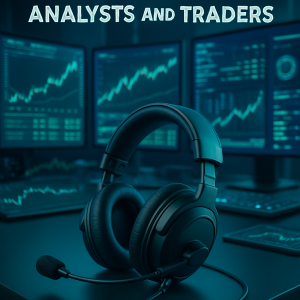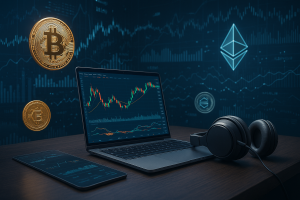My name is Mariana Souza. I hold a degree in Communication and specialize in product analysis. Over the years, I’ve evaluated dozens of tech tools used by crypto analysts, traders, and content creators. A good headset often becomes the silent partner in many strategic decisions.
In crypto spaces, audio is more than a convenience. It shapes how traders react to live market data, respond to fast-moving signals, and collaborate with teams. Precision audio translates into faster, clearer decision-making. And poor sound? That can mean missed chances.
Understanding the role of audio in crypto trading
Many traders operate in real-time environments. Voice chat rooms, Discord servers, and Telegram calls serve as central hubs for information exchange. Audio delays or glitches can ruin split-second decisions.
Day traders rely on audio signals just like they rely on visual charts. Voice-led analysis, live commentary, and call-ins with crypto communities all depend on headset quality. Noisy backgrounds or unclear speech disrupt workflow.
Clear audio ensures trust in the signal. Traders hearing every nuance avoid costly misinterpretations. And when millions ride on timing, clarity wins.
Key features of a good headset for crypto use
Noise cancellation ranks at the top. Markets are chaotic. A headset that blocks out background noise helps users stay focused during volatile hours.
Mic quality matters too. Crypto traders often host AMAs, live discussions, or collaborate on NFTs and DeFi strategies. A muffled mic ruins the experience for all parties involved.
Multiplatform compatibility also helps. Devices used in crypto range from PCs to smartphones. Headsets must switch smoothly between them without lag or pairing issues.
Long sessions are common. Traders and analysts monitor trends for hours. Headsets must be lightweight and breathable. Ear cushions with memory foam and adjustable headbands reduce fatigue.
Comparing wired vs wireless headsets for crypto activities
Wired headsets offer stable connections. No battery issues or interference. That’s crucial when uptime defines opportunity. But the cables can limit movement, especially during multitasking.
Wireless headsets offer freedom. You can stretch, walk, or switch setups easily. They suit content creators recording voiceovers or traders managing multiple screens.
Bluetooth versions matter. Headsets with Bluetooth 5.2 or newer improve range and reduce latency. Some models feature dual connectivity—useful when balancing crypto chats and phone alerts.
Best headsets for crypto analysts and traders

1. SteelSeries Arctis Nova Pro Wireless
This headset stands out with its multi-system connect feature. Crypto users often run several devices. It handles PCs, consoles, and smartphones seamlessly. The dual-battery design keeps it powered around the clock. It also offers active noise cancellation and a broadcast-quality mic.
2. Audio-Technica ATH-G1WL
This model balances quality and simplicity. The sound profile helps capture high-frequency tones found in voice chats. Low latency wireless performance suits fast-paced environments. Though it lacks ANC, the closed-back design isolates most ambient sound.
3. Corsair Virtuoso RGB Wireless XT
This option works well for both trading and streaming. It features hi-res audio and a detachable mic. The Bluetooth and 2.4GHz dual-wireless setup ensures reliable audio during multitasking. Comfort-wise, it fits well during prolonged sessions.
Audio fatigue and its impact on crypto decision-making
Audio fatigue creeps in during long trading marathons. It reduces attention span and leads to decision errors. Headsets with overly sharp highs or booming lows contribute to this problem.
Neutral audio tuning and comfortable design reduce strain. Adjustable clamping force, padded earcups, and soft headbands help users stay alert longer. Some models feature low-frequency compensation to avoid distortion over time.
Traders who spend hours analyzing NFT launches, ICO discussions, or DeFi governance calls benefit from headsets built for all-day wear. Healthy ears lead to sharper minds.
Security and privacy considerations when using headsets
In the crypto world, privacy ranks high. Many traders share sensitive data via voice. Bluetooth headsets without strong encryption create risk vectors for attackers.
Look for models using AES encryption or advanced pairing protocols. Some headsets support dedicated USB dongles with secure channels. These reduce chances of third-party interception.
Headsets that integrate mute indicators and mic kill-switches offer extra peace of mind during confidential talks. Trading desks dealing with high-volume portfolios rely on such features daily.
Tips for choosing the right headset based on crypto workflow
Scalpers and day traders need lightweight headsets with minimal latency. Wired options often suit this role better. Quick trades demand fast response and reliability.
Technical analysts reviewing charts or producing market breakdowns need audio precision. Studio-like sound helps detect voice fluctuations in collaborative environments.
Content creators working with crypto podcasts or YouTube reviews benefit from headsets with detachable mics and clean voice pickup. Flexibility adds value during multi-step workflows.
Those active in governance proposals or tokenomics discussions value comfort and clarity. Long Zoom calls and DAO meetings need headsets that won’t wear users out.
Final thoughts
Headsets shape the way crypto professionals work. They influence trade execution, teamwork, and user comfort. Choosing the right one boosts performance across different crypto-related tasks.
Whether managing a DeFi portfolio, analyzing new altcoins, or sharing insights on Twitter Spaces, audio tools must keep up. Look beyond flashy designs. Evaluate sound tuning, device compatibility, and comfort over long hours.
How sound quality affects crypto multitasking
Crypto traders rarely focus on one task. They juggle news feeds, market orders, voice chats, and price charts. A headset that delivers crystal-clear audio helps users stay organized in chaos.
Audio layering becomes important. Distinguishing between a trading call and alert tones helps avoid mistakes. Sound clarity prevents confusion during high-frequency sessions.
Some headsets support customizable EQ profiles. This allows users to emphasize voice over background audio. In crypto spaces, that small tweak saves minutes—and sometimes money.
Evaluating mic sensitivity for crypto content creators
Those building a brand in cryptos often record content. Podcasts, Twitter Spaces, or YouTube videos rely heavily on mic quality. A dull or noisy microphone weakens your voice and credibility.
Cardioid mic patterns help isolate speech. This limits keyboard clatter or mouse clicks during recording. Look for headsets offering broadcast-level microphones with low self-noise ratings.
Streaming from noisy environments? Choose headsets with mic monitoring and noise gate settings. These features prevent accidental background audio from entering your crypto streams.
Importance of firmware updates and support for crypto workflows
Firmware support adds longevity to headsets. Brands like SteelSeries and Corsair offer regular updates. These fix pairing bugs, enhance battery life, and improve audio calibration.
Crypto environments evolve fast. Traders adopt new apps, switch exchanges, and run plugins daily. Firmware support ensures headsets stay compatible with changing platforms.
Check if the manufacturer provides desktop apps for tweaking sound settings. Some allow multiple profiles. That’s helpful when switching from trading to content creation in seconds.
Cross-platform compatibility for diverse crypto tasks

Crypto work happens across devices. Desktop trading platforms, mobile wallets, browser extensions, and virtual meeting apps all play a role. Your headset must keep up with this diversity.
Headsets with simultaneous dual connections let users link to a laptop and phone together. This helps when trading on desktop while joining a live AMA from mobile.
USB-C dongles work best for modern crypto devices. Avoid models that limit audio output to legacy USB-A ports or proprietary connections.
Advanced headset materials and their impact on crypto use
Crypto pros often wear headsets for 8 hours or more. Breathable mesh ear pads and lightweight aluminum frames reduce discomfort. Overheating and pressure points hurt productivity.
Memory foam padding molds to the ear. That reduces pressure during long research or DAO voting sessions. Headsets with swappable parts increase longevity and hygiene.
Materials matter in remote environments too. Crypto workers traveling between coworking spaces or conferences need rugged, portable gear. Durable headsets survive the movement.
Creating a focused environment using audio tools
Crypto spaces never sleep. Alerts, chats, and chart movements can be overwhelming. Using ambient sound profiles or built-in white noise reduces distractions.
Some headsets integrate with productivity platforms. This allows users to mute notifications during high-priority calls or trades. When focus counts, audio becomes a boundary.
Noise isolation works both ways. It blocks distractions while also signaling to others that you’re deep into a session. This helps protect your mental workflow in crypto environments.
What crypto communities say about good headsets
Reddit forums like r/CryptoCurrency and r/Daytrading often feature headset reviews. Traders rank products based on latency, mic clarity, and comfort during bull runs or bear markets.
Discord groups run polls on headset preferences. Streamers and crypto educators favor wireless models for flexibility. Analysts lean toward wired sets for reliability.
Twitter Spaces hosts often recommend headsets tested under live broadcast conditions. Peer feedback helps avoid buying mistakes, especially when gear becomes part of daily crypto routines.
Future trends in headsets for the crypto world
New models may include biometric sensors. These track fatigue and suggest breaks—ideal during 10-hour NFT drops or DAO negotiations. Some brands explore AI noise filtering, which learns and adapts to user environments.
Integration with blockchain tools may emerge. Headsets linked to wallet apps could verify identities during private meetings or secured voting. Audio devices might soon offer multi-layered authentication.
As virtual reality enters crypto education and meetings, spatial audio headsets will grow in demand. 3D sound enhances immersive blockchain experiences and makes virtual collaboration feel real.
Find what fits your crypto style. Let performance—not just price—guide the choice. A reliable headset becomes a strategic edge in digital finance.
